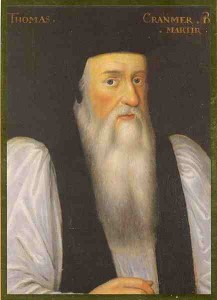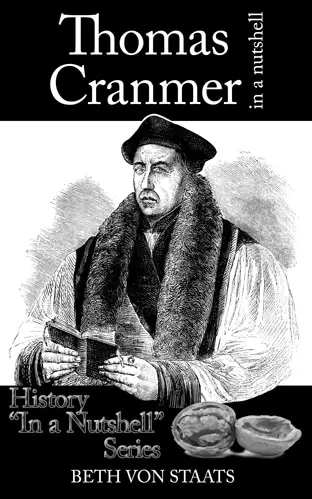 Every year on 21st March, I spare a thought (or actually quite a few!) for Thomas Cranmer, Archbishop of Canterbury during the reigns of Henry VIII and Edward VI, who was burnt at the stake on 21st March 1556 at Oxford. He has gone down in history as one of the Oxford Martyrs, along with Bishops Latimer and Ridley, one of the Protestant martyrs of Mary I’s reign.
Every year on 21st March, I spare a thought (or actually quite a few!) for Thomas Cranmer, Archbishop of Canterbury during the reigns of Henry VIII and Edward VI, who was burnt at the stake on 21st March 1556 at Oxford. He has gone down in history as one of the Oxford Martyrs, along with Bishops Latimer and Ridley, one of the Protestant martyrs of Mary I’s reign.
Thomas Cranmer had previously been found guilty of high treason and condemned to death in 1553, but instead was imprisoned and then tried for heresy with Hugh Latimer and Nicholas Ridley on 12th September 1555. Ridley and Latimer were found guilty immediately and were burnt at the stake on the 16th October 1555 but Cranmer had to wait for a final verdict from Rome. On the 4th December, Rome took the post of archbishop away from Cranmer and gave permission to the secular authorities to decide Cranmer’s sentence. His execution was then set for the beginning of March 1556.
This is when Cranmer’s story really hits me and reminds me, actually, of St Peter who denied Christ three times and yet was the rock on which Christ said he’d build his church. Like Peter, Cranmer denied his true faith by making five recantations and accepting Catholic theology, repudiating Reformist theology, stating that there was no salvation outside of the Catholic Church and announcing that he was happy to return to the Catholic fold. These actions should have resulted in Cranmer being absolved, but although his execution was postponed temporarily a new date was then set for 21st March.
On the day of his execution, Cranmer was told to make a final recantation, but in an act of defiance and as a testimony to his true faith he actually renounced his recantations and spoke out against the Pope as “Christ’s enemy, and antichrist, with all his false doctrine.”. He also said he would punish his hand for signing the recantations by putting it in the fire first. In his account of Cranmer’s execution, martyrologist John Foxe writes of how Cranmer did just this: “then it was, that stretching out his right hand, he held it unshrinkingly in the fire till it was burnt to a cinder, even before his body was injured, frequently exclaiming, “This unworthy right hand!””
He died courageously and as a martyr to his faith.
You can read more about Thomas Cranmer in the following articles:
- The Life of Archbishop Thomas Cranmer
- Thomas Cranmer becomes Archbishop of Canterbury
- The Unlawful Execution of Thomas Cranmer
And I’d highly recommend Beth von Staats’ book on Cranmer, Thomas Cranmer in a Nutshell, if you want to know even more about him.

Peter wasn’t the rock the lord Jesus is he said though art Peter which in the Greek is Cephus which means small stone and the lord Jesus went on to say and on this rock referring to himself I will build my church and the gates of hell shall not prevail against it Archbishop Cranmer would have know this the lord Jesus is the head we are the body
It does indeed depend how you interpret Christ’s words and there has been controversy over what Christ said and what it meant for centuries. “Cephas” is Aramaic and the controvery has surrounded the Greek words “Petros” and “Petra” in the quote I was referring to : “And I say also unto thee, That thou art Peter (Petros), and upon this rock (petra) I will build my church; and the gates of hell shall not prevail against it.” As I said, there in controversy over whether Christ was referring to building his Church on Peter as the rock (hence the Catholic view that Peter was the first Pope etc.), on Peter’s confession of Jesus as “the Christ, the Son of the Living God”, or whether Christ was actually referring to himself.
There is an excellent article on this at http://www.greatcommission.com/Matthew161720.html
As a Protestant, I don’t see these words as supporting the idea but I also don’t see there being a contradiction between Peter being the rock on which the Church would be built and Christ being the only head of the Church. Those that were left behind by Christ did build his Church, they wwre fishers of men and it was because Christ was alive in them, or so I believe.
Obviously we all have different views on this verse but I’m in agreement with the article I mentioned, that Christ “chose Peter for the task of opening the doors of the kingdom of God to the world” and that he was talking about Peter’s role as a rock-foundation.
That’s a useful and interesting page, Claire. Thanks for linking it.
I looked up Tyndale’s translation, and even there it’s hard to escape the conclusion that Peter was the rock on which would be built. I’ve left out what would be built, because that is different in Tyndale:
And I saye also vnto the yt thou arte Peter: and apon this rocke I wyll bylde my congregacion. And the gates of hell shall not prevayle ageynst it. And I wyll geve vnto the the keyes of the kyngdom of heven: and whatsoever thou byndest vpon erth shall be bounde in heven: and whatsoever thou lowsest on erthe shalbe lowsed in heven.
From http://www.biblestudytools.com/tyn/matthew/16.html
Even there the “I will give unto thee” part is hard to fit with interpretations in which Peter isn’t the rock. “Congregation” makes the “Pope” interpretation harder to make, however.
i can’t even begin to imagine the terror Cramner felt. Another black mark against Mary’s reign.
It was a very personal judgement againt Cramner as he was the man who granted the annulment against Henry’s marrage to Katherine of Aragon
Personal, yes, but perhaps more to do with later reasons: Cranmer supported the Protestant Jane Grey for Queen and that was high treason from Mary’s POV.
I do not think Cranmer was an ideal martyr as he tried to save his life by renouncing his beliefs and only when it failed and his death was sure, he tried to said them aloud.
I always thought that Cranmer had actually been convicted of treason for his support of Lady Jane Grey. Pity that Mary didn’t punish him for that crime .. where recantation doesn’t legally block a death painful enough to satisfy Mary’s desire for revenge.
Anyanka,
Exactly.
King James Bible
“And I say also unto thee, That thou art Peter, and upon this rock I will build my church; and the gates of hell shall not prevail against it.” — Matthew 16:18
Whether Saint Peter is considered the rock that Christianity was built upon and the first Pope depends on one’s interpretation of scripture and religious beliefs. The comparison Claire uses therefore is a relevant one from that regard. I found it a lovely comparison personally. Comparing a Catholic interpretation to a Protestant martyrdom is in no way a conflict to the religious ironies of the 16th century.
Specific to Thomas Cranmer, more than 40 years into his life. he began rejecting the notion of a Papal authority through his devout belief in the royal supremacy. This in itself does not mean he did not believe Popes existed. In fact, he did as to Cranmer’s belief, the Pope was the antichrist. So, my educated guess is that the scripture above may have been interpreted by Cranmer to mean that Roman Catholic Church was built upon the rock of the antichrist.
Regardless of how the scripture is interpreted, the Bible does suggest in story telling that Peter denied Christ as messiah 3 times, but then ultimately became steadfastly devout. The same can be said true of Thomas Cranmer.
Just to clarify the last statement, I do not mean that Cranmer denied Christ in his recantations, but instead religious truth as he believed it to be.. In that was, the comparison to Saint Peter is a valid one.
Was Dr Cranmer, as a heretic, considered a “social revolutionary”? (a heretic being accused both of doctrinal error and initiating or inciting revolution and therefore as much an enemy of the state as of the church, there being no separation between the two?) Got a feeling I’ve read something from Claire on this sometime ago. Can’t remember what she said. If she, in fact, did.
To Esther
I am reading Diarmair MacCullough’s biography of Cranmer and he points out that Mary was not “especially vindictive” in the matters of treason. But from Mary’s POV, Cranmer had led the whole country to heresy.
MacCullough made me understand that, while Cranmer admitted on his road to the stake that he would have done anything in order to save his life, that meant also the belief that all men are sinners and can be saved only from God’s grace.
I think the death for treason was even crueller. Henry killed a few for that and also for religioous reasons.